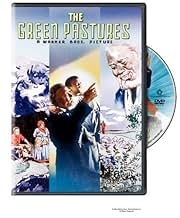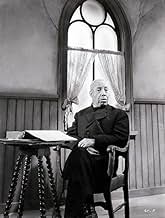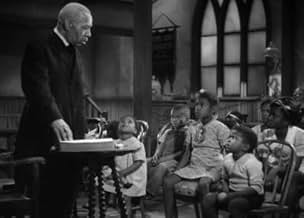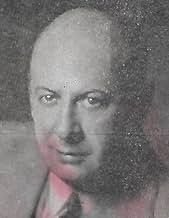Füge eine Handlung in deiner Sprache hinzuGod, heaven, and several Old Testament stories, including the Creation and Noah's Ark, are described supposedly using the perspective of rural, black Americans.God, heaven, and several Old Testament stories, including the Creation and Noah's Ark, are described supposedly using the perspective of rural, black Americans.God, heaven, and several Old Testament stories, including the Creation and Noah's Ark, are described supposedly using the perspective of rural, black Americans.
- Regie
- Drehbuch
- Hauptbesetzung
- Auszeichnungen
- 4 wins total
Eddie 'Rochester' Anderson
- Noah
- (as Eddie Anderson)
Frank H. Wilson
- Moses
- (as Frank Wilson)
Edna Mae Harris
- Zeba
- (as Edna M. Harris)
Charles Andrews
- Flatfoot
- (as Chas. Andrews)
Billy Cumby
- Abraham
- (as William Cumby)
- …
Empfohlene Bewertungen
The origins of The Green Pastures are from the anthology of stories published by writer Roarke Bradford who entitled his volume Ol Man Adam An' His Chillun. Written in 1928 it was adapted into a play by Algonquin Round Table member Marc Connelly and for an incredible 640 performances during the height of the Depression. In 1936 Warner Brothers purchased the rights and did this film version of the play utilizing a whole load of black players in the film colony.
The Green Pastures got two revivals on Broadway, but you don't hear of it being revived in the post Civil Rights era. It hasn't had the staying power at all of Porgy and Bess which had similar origins.
The story is told from the eyes of a child in a rural black church's Sunday school who is hearing the story of Genesis and imagining what the people would be like in her mind. De Lawd is played by Rex Ingram and this would become two of his career roles, the other being the genie in The Thief Of Bagdad. Personally I can imagine him being God far better than George Burns.
The characters of the Bible are for these people invested with a lot of human qualities, more like the Greek and Roman deities of antiquity than the traditional white Christian view. My favorite scene is the one where the only good man in a world awash with sin is that preacher Noah played by Eddie Anderson. When Ingram visits him and tells him he's starting over and to build an ark and take male and female of everything for breeding, Anderson starts haggling with De Lawd over the amount of spirits to be taken on this sea voyage for medicinal purposes only you understand.
Of course the Ark does its 40 days and 40 nights thing and then just sails around until some land starts to emerge. Personally back in those days polygamy was in and I never understood why Noah and the boys didn't have some extra wives along. The task before them might have been fun, populating the earth again, but it sure put a strain on their wives.
A film like The Green Pastures has a childlike innocence about it, it would have to in order to succeed on stage and screen. It's not likely to see any revivals due to changing times and sensitivities. But it remains an entertaining if quaint vehicle today.
The Green Pastures got two revivals on Broadway, but you don't hear of it being revived in the post Civil Rights era. It hasn't had the staying power at all of Porgy and Bess which had similar origins.
The story is told from the eyes of a child in a rural black church's Sunday school who is hearing the story of Genesis and imagining what the people would be like in her mind. De Lawd is played by Rex Ingram and this would become two of his career roles, the other being the genie in The Thief Of Bagdad. Personally I can imagine him being God far better than George Burns.
The characters of the Bible are for these people invested with a lot of human qualities, more like the Greek and Roman deities of antiquity than the traditional white Christian view. My favorite scene is the one where the only good man in a world awash with sin is that preacher Noah played by Eddie Anderson. When Ingram visits him and tells him he's starting over and to build an ark and take male and female of everything for breeding, Anderson starts haggling with De Lawd over the amount of spirits to be taken on this sea voyage for medicinal purposes only you understand.
Of course the Ark does its 40 days and 40 nights thing and then just sails around until some land starts to emerge. Personally back in those days polygamy was in and I never understood why Noah and the boys didn't have some extra wives along. The task before them might have been fun, populating the earth again, but it sure put a strain on their wives.
A film like The Green Pastures has a childlike innocence about it, it would have to in order to succeed on stage and screen. It's not likely to see any revivals due to changing times and sensitivities. But it remains an entertaining if quaint vehicle today.
I watched this movie late at night with a bunch of munchkins and wondered why more of the adults didn't come watch it with us... It is a unique, well-made, unassuming, enjoyable, surprising, well-told "story." I say "story," because it is a description more than a tale of one way to conceive of the "Lawd of heaven." Gotta love the southern accents. They did a great job and left me rethinking the way I thought of things and smiling as I thought of the way they portrayed it all. It was also curious to me to see how society's perception of music, race, and Sundays has changed, but how some things never change.
Favorite quote... by "The Lawd" - "I'm going ta make me a miracle"
Favorite quote... by "The Lawd" - "I'm going ta make me a miracle"
Before I get into the film itself, here's the little known back-story. Roark Bradford, a white Tennesseean, was mesmerized as a boy by the sermons of a black preacher named John Wesley Henning (aka "Preacher Wes). Rev. Henning entertained and educated his audiences with imaginative biblical tales done in a fashion in which his rural black audiences could relate. Years later in 1928, Henning's twists on biblical tales were the basis of Bradford's book "Ol Man Adam and His Chillun." Marc Connely enjoyed the book, and the result was the play and film "The Green Pastures." The film and play adds the charming frame device of Mr. Deeshay, a black Sunday school teacher telling the Biblical tales from Bradford's text with Noah, Adam. Moses, et.al. as Southern rural blacks. Much has been said about the dialect and stereotypes. Fact is, the dialect is pretty close to the truth of this time and place, as my parents were of that generation (there is a reference to "Sonny Kick Mammy Wine." My parents would make me laugh at their description of a popular moonshine called "Fight Your Mama" that was supposed to have been so potent that it would make the drinker do as the title suggested).
However, the film, as well as much of Bradford's work, is filled with moving truths about the human condition. Witness the dialog between a pre-Rochester Eddie Anderson as Noah and the dignified Rex Ingram as God, as well as the observations about human nature made throughout the film. As for ending, I won't spoil it, but the final scene before the credits says the true message of the film without saying a word. Watch it with an open mind, enjoy, and think.
Incidentally, in 1963, the great comedian Mantan Moreland (who had a bit part as an angel in "The Green Pastures") went back to the source and recorded an album of tales from the source "Ol Man Adam And His Chillun." It's as delightful as the film and along with the original books, make a great addendum to the film.
However, the film, as well as much of Bradford's work, is filled with moving truths about the human condition. Witness the dialog between a pre-Rochester Eddie Anderson as Noah and the dignified Rex Ingram as God, as well as the observations about human nature made throughout the film. As for ending, I won't spoil it, but the final scene before the credits says the true message of the film without saying a word. Watch it with an open mind, enjoy, and think.
Incidentally, in 1963, the great comedian Mantan Moreland (who had a bit part as an angel in "The Green Pastures") went back to the source and recorded an album of tales from the source "Ol Man Adam And His Chillun." It's as delightful as the film and along with the original books, make a great addendum to the film.
10Greg-83
I first saw "The Green Pastures" quite by accident as a 13 year-old while visiting grandparents in Detroit, Michigan many, many years ago...I never forgot it.
Years later, in college, while on a date, I was telling my date about it and we stopped by the school library so I could find a copy of the play to show her...she loved it, too. I've since bought the tape and watch it every now-and-then when I want to smile and feel good.
I remember asking my mom about the movie when I first saw it and always remembered her response..."how do you think the little black children in the movie pictured God and others in the Bible?" And that, of course, is exactly what Marc Connelly was trying to get us to think about.
Though the original play/movie may have met resistance in the South, it was a hit in New York. To the eternal historical revisionists of today who see nothing but stereotypes and negative images, I'd suggest you take another look.
Country folk of the early part of this century did talk with accents and few had much education (whites as well as blacks). The dialog of the film is less a contrived stereotype than it is a snapshot of what the simple life was like. It's not hard for me to imagine a dedicated Mr. Deshee teaching kids in Sunday School about the good book. Nor is it hard to understand why they might picture pharoe's guards in double-breasted suits like the gangsters in the news of their youth, or relating any number of other scenes to what was familiar to them.
Connelly was not trying to convert viewers to religion...he was trying to get those already converted to see the personal relationship with God enjoyed by all his children, regardless of their station in life.
There are no whites in the movie, just as there were no whites in the immediate community where the story takes place. This movie was not made with the burden of every social dilemma we've struggled with over the years. To blindly force modern perceptions and racial baggage on it does nothing but dampen the simple joy of this unique gem.
Years later, in college, while on a date, I was telling my date about it and we stopped by the school library so I could find a copy of the play to show her...she loved it, too. I've since bought the tape and watch it every now-and-then when I want to smile and feel good.
I remember asking my mom about the movie when I first saw it and always remembered her response..."how do you think the little black children in the movie pictured God and others in the Bible?" And that, of course, is exactly what Marc Connelly was trying to get us to think about.
Though the original play/movie may have met resistance in the South, it was a hit in New York. To the eternal historical revisionists of today who see nothing but stereotypes and negative images, I'd suggest you take another look.
Country folk of the early part of this century did talk with accents and few had much education (whites as well as blacks). The dialog of the film is less a contrived stereotype than it is a snapshot of what the simple life was like. It's not hard for me to imagine a dedicated Mr. Deshee teaching kids in Sunday School about the good book. Nor is it hard to understand why they might picture pharoe's guards in double-breasted suits like the gangsters in the news of their youth, or relating any number of other scenes to what was familiar to them.
Connelly was not trying to convert viewers to religion...he was trying to get those already converted to see the personal relationship with God enjoyed by all his children, regardless of their station in life.
There are no whites in the movie, just as there were no whites in the immediate community where the story takes place. This movie was not made with the burden of every social dilemma we've struggled with over the years. To blindly force modern perceptions and racial baggage on it does nothing but dampen the simple joy of this unique gem.
The Green Pastures enacts Old Testament Bible stories as seen through the eyes of rural black children. The movie begins in a ramshackle church, generations ago, presumably in the Deep South. As the Sunday School teacher relates the Bible stories we are transported to Heaven to witness the Creation, the Banishment from the Garden of Eden, the Flood, and the Exodus. An all-black cast, speaking in the rural idiom, and set in modern day (1930s) surroundings makes for one of the most unique movies you will ever see.
All the pieces fit together perfectly. It's a joy to watch, deeply spiritual, and the gospel choir accompaniment is an added treat. Grade A.
All the pieces fit together perfectly. It's a joy to watch, deeply spiritual, and the gospel choir accompaniment is an added treat. Grade A.
Wusstest du schon
- WissenswertesThe studio's anxiety about this film's all-Black cast is evident in the film's 3:48 minute trailer. It consists of white actor Dick Powell talking directly to the camera, white workers preparing costumes and props, and author Marc Connelly explaining the rationale for the bare sets to a studio executive. According to Connelly, it is how a "simple, devout" people would imagine heaven. At no time are Rex Ingram or any of the film's other stars shown in the preview, and there is only a brief sequence of black extras in a long shot.
- PatzerOne of Noah's son's rides a zebra that is clearly a donkey or mule made to look like a zebra. Two real zebras are loaded while he rides the fake.
- Crazy CreditsGod appears in many forms to those who believe in Him. Thousands of Negroes in the Deep South visualize God and Heaven in terms of people and things they know in their everyday life. The Green Pastures is an attempt to portray that humble, reverent conception.
- VerbindungenEdited into Governing Body (2023)
- SoundtracksHave You Got Good Religion (Certainly, Lord)
(uncredited)
Traditional spiritual
Performed by the Hall Johnson Choir
Top-Auswahl
Melde dich zum Bewerten an und greife auf die Watchlist für personalisierte Empfehlungen zu.
- How long is The Green Pastures?Powered by Alexa
Details
- Erscheinungsdatum
- Herkunftsland
- Sprache
- Auch bekannt als
- Neger erzählen die Bibel
- Drehorte
- Produktionsfirma
- Weitere beteiligte Unternehmen bei IMDbPro anzeigen
- Laufzeit1 Stunde 33 Minuten
- Farbe
- Sound-Mix
- Seitenverhältnis
- 1.37 : 1
Zu dieser Seite beitragen
Bearbeitung vorschlagen oder fehlenden Inhalt hinzufügen

Oberste Lücke
By what name was The Green Pastures (1936) officially released in India in English?
Antwort


























